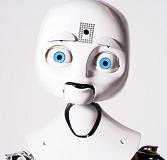 Here we are, well into the second decade of a new millennium, and not only is there a conspicuous absence of jet packs, but also no robot butler made my breakfast this morning. Domestic robots are not completely unknown, of course. There’s the famous vacuuming Roomba, and home-based medical robots are starting to appear. Yet, while robots are ubiquitous in industry, and rapidly expanding in the military sphere, their presence in our homes is minimal.
Here we are, well into the second decade of a new millennium, and not only is there a conspicuous absence of jet packs, but also no robot butler made my breakfast this morning. Domestic robots are not completely unknown, of course. There’s the famous vacuuming Roomba, and home-based medical robots are starting to appear. Yet, while robots are ubiquitous in industry, and rapidly expanding in the military sphere, their presence in our homes is minimal.
Both Greg Shirakyan in the Microsoft Robotic Blog and Keith Wagstaff in Time magazine write about the lack of domestic unmanned systems. They mention a number of obstacles, including autonomy problems, cost, safety, security and the absence of standardization.
One issue that caught my attention was interactivity with the environment. In his Microsoft Blog posting, Shirakyan states that putting a robot in a typical human-oriented kitchen is akin to asking a super-smart cat to make you a meal. Despite its intelligence, the poor feline simply doesn’t have the tools to perform simple tasks.
Shirakyan assumes that we will modify our environment to accommodate our robot servants. I’m not so sure. I raised this issue in Walk N’ Roll, which discusses whether robots should have legs or wheels. As I phrased it, “Are we going to adapt the human environment to robots or robots to the human environment?” Clearly, human-like robots will be more expensive, but changing our living spaces to be robot friendly will also be costly. A major barrier to domestic robots may be that developers simply do not know what kind of robot to create.
Maybe even more important are interactions in the social environment. Shirakyan writes that “We may change our environment to help blue collar bots excel at their jobs, but we can’t modify our own nature…” He thinks this is especially important in “white collar” tasks, which involve a high degree of human interaction.
In Newsweek’s Studying Human-Robot Interactions, Dan Lyons describes research by Menlo Park-based Willow Garage. Their goal is to make robots “less intimidating,” because “…the age of personal robots is approaching. In a decade or two these mechanical helpers could be doing chores in our homes…”
Sometimes the robotic changes the researchers recommend are modest. The article describes a robot standing at a door, attempting to figure out how to open it. A human observing the robot, will conclude that it is doing nothing, just standing still. The researchers added unnecessary movement to the robot’s head. Observing these movements, a human will recognize the task the robot is performing and can assist it in learning this task.
Understanding a robot’s motivation is critical when working with it. In this blog’s Autonomy, Situational Awareness, and the User Interface — Part 2, noted expert David Bruemmer said that “…human operators may experience greater frustration and less trust with vehicles as they become more autonomous.” In other words, it’s not enough that we create unmanned systems that are intelligent and autonomous; their motivations must be transparent. If you order a robot to prepare a meat dish, and you see it sharpening a knife while moving toward a dog, it’s important that you understand that the robot intends to go around the family pet.
Trust of a different kind is also mentioned by Shirakyan in his Microsoft Blog posting. A domestic robot will become so intimate in our lives, that a hacked unmanned servant would be a greater threat than a zombie PC. I don’t entirely agree with this; I don’t see the security issues of a robot being inherently greater than that of a PC. However, it’s entirely possible that people may feel more vulnerable, whether it’s true or not. An autonomously moving robot may seem more alive than a stationary computer, and thus could be perceived as more threatening.
In his Time article, Wagstaff describes a different kind of anxiety about household robots. He worries that the typical metal construction is too strong for “fragile” humans. That PackBot sure is cute, but do you really want one in your living room around your kids?
Both Wagstaff and Shirakyan doubt that a full-service robotic maid is coming soon. In fact Wagstaff thinks cost will always be a prohibitive factor. We will have robots, but they will be a multitude of small single-purpose systems, rather than a single do-it-all machine.
So, Rosie the wisecracking robot from the Jetsons will likely remain a cartoon fantasy, but the little Roomba will have lots of company.








I’m also looking forward to robot butlers! I don’t know about smaller appliances doing the various chores though, because in the end it’s going to be affordable by a really small percentage of customers, i.e. not really profitable. I guess a robot that would at least be able to perform a few basic tasks would be more appropriate, even if it means waiting a little longer.